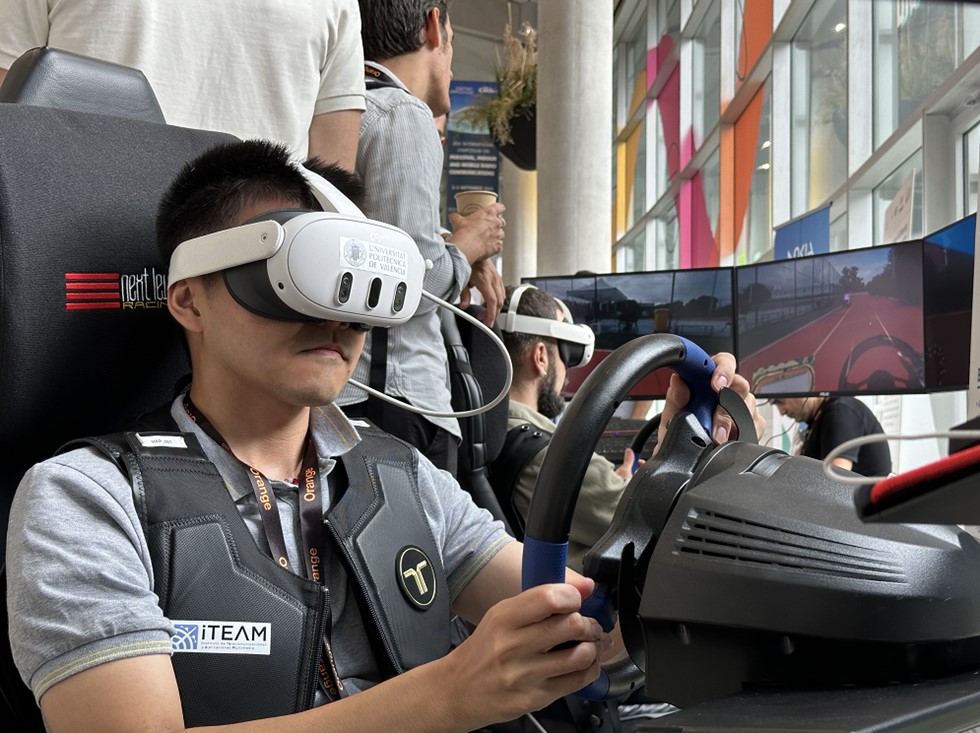One of the use cases of this project was the 5G Robot Race, a race of remotely driven robots.
The work of the iTEAM UPV-Orange team will contribute to greater safety and efficiency in human-robot interaction.
The Mobile Communications Group of the Institute of Telecommunications and Multimedia Applications (iTEAM) at the Universitat Politècnica de València (UPV) and Orange (Grupo MasOrange) have developed an innovative immersive remote driving system powered by 5G technology.
This remote driving system is based on three main nodes: the user node, the robot node, and the 5G communication network node. The first enables remote control of the robots through peripheral devices—specifically, a steering wheel and pedals—along with an immersive user interface. The robot node consists of the robots themselves, incorporating various sensors that facilitate teleoperation and remote driving. The 5G network node supports communication between the driver and the robot, ensuring reliable, high-speed data transmission.
“Thanks to 5G technology, remote driving is performed with minimal latency, ensuring a stable and secure connection between the user and the robot, even when they are in separate locations,” highlights David Gómez-Barquero, Deputy Director of Research at the iTEAM Institute of the Universitat Politècnica de València.
Additionally, within the project framework, an interface was developed for augmented reality glasses and gaming screens, allowing users to experience real-time 360º video of the robots’ surroundings. It also incorporates augmented reality objects overlaid on the video, haptic feedback to simulate physical interactions, and a digital twin of the velodrome where the demonstration took place. “All of this enables detailed real-time monitoring of the robot’s status,”adds Íñigo Polo, Director of Public Administration and Digital Services.
One of the use cases of this project was the 5G Robot Race, a robot race controlled remotely through an immersive user interface equipped with augmented reality and haptic feedback (the use of tactile sensations to communicate information to users, such as vibrations)—two technologies that enhance the user experience.
The validation of this technology was carried out in real-world operating environments during the IEEE PIMRCand One6G Summit events held last year in Valencia.
Future Development Lines
This use case has great potential to integrate emerging technologies that improve precision, sensory response, and autonomy in human-robot interaction.
Among the key future development areas, the iTEAM-UPV and Orange team will focus on implementing Mixed Reality (XR) to merge the physical and virtual worlds, enabling a more realistic manipulation of digital objects.
“Additionally, incorporating advanced haptic sensitivity through vests or suits will enhance environmental perception. We will also work on optimizing connectivity using 5G/6G networks with specific functions to ensure low latency in critical operations,” adds David Gómez-Barquero, Deputy Director of Research at iTEAM-UPV.
Intelligent Assistance for Remote Driving
Another key focus for the UPV-Orange team is the development of AI algorithms for intelligent assistance in remote driving, obstacle detection, and video quality optimization. Moreover, integrating advanced sensors and predictive data analysis will facilitate early failure detection and improve robot navigation using Machine Learning techniques.
“With these innovations, we expect greater safety, efficiency, and adaptability in human-robot interaction,” adds Raúl Lozano Teruel, a researcher at iTEAM of the Universitat Politècnica de València.
The collaboration between Orange and UPV was carried out within the framework of the project “Advancing 5G Immersive for Haptic Communications” (TSI-0630002021-111) under the Universalization of Digital Infrastructure Program for Cohesion – 5G R&D (UNICO-5G R&D). Recovery, Transformation, and Resilience Plan, Ministry of Economic Affairs and Digital Transformation, financed by the European Union – NextGenerationEU.

